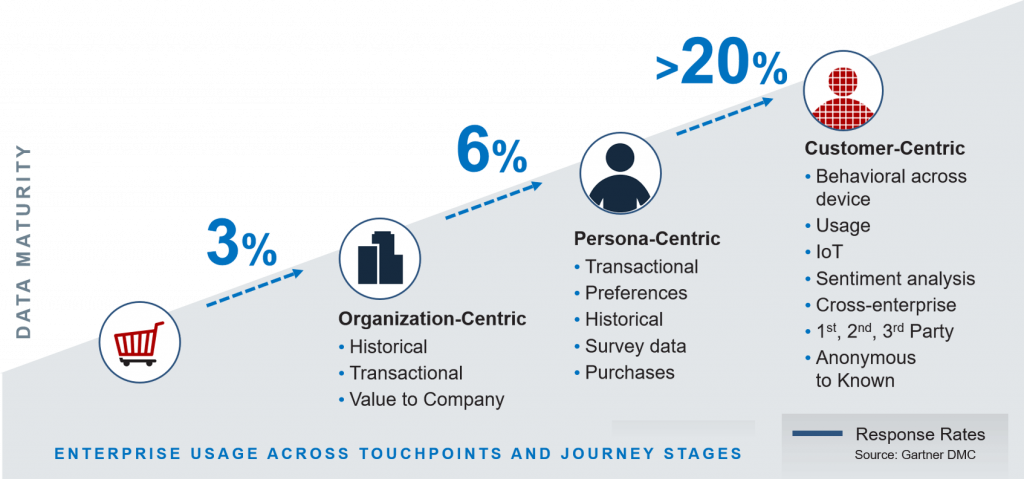 What is customer centricity and why is it important?
What is customer centricity and why is it important?
The customer centricity definition is simply a strategic approach to customer experience, leveraging data to provide highly relevant experiences across the entire lifecycle.
It’s more than providing satisfactory customer service over the phone or in store. We’re living in an omnichannel world and customers expect personalization at every moment of interaction.
Rather than promoting products and services in a batch and blast manner, customer centricity is the idea that every moment of interaction a consumer has with your brand is extremely relevant. Gaining insight into customer context and cadence enables you to maintain that level of hyper-personalization.
Ultimately, it’s a value exchange: if you treat each individual as a segment of one, they will reward you in revenue. Prioritizing a customer-centric approach to customer experience (CX) increases acquisition, retention, and lifetime value.
What Does it Mean to be a Customer-Centric Organization?
Achieving customer centricity means that you’re able to provide customers with dynamic, contextually relevant experiences.
Gartner notes that the maturity of your data impacts your ability to become customer-centric.

By incorporating more than just historical and transactional data in your approach, you can enhance CX and increase engagement.
Integrating all your data across every touchpoint and running analyses on that data provides you with actionable insights you can leverage to deliver customer-centric experiences.
You know your brand is customer-centric when:
- You understand the context and cadence of every customer
- You can treat each consumer as a segment of one
- You can personalize not just the path to purchase, but their experience across the entire lifecycle
Of course, this requires you to know all that is knowable about your customer. To achieve this level of maturity in customer understanding, it’s essential to:
- Ingest and integrate all types and sources of customer data
- Accurately resolve customer identities across every touchpoint
- Build a Golden Record: a combination of all customer behavior – from anonymous to known stages – that persists over time
- Analyze customer interactions and determine next-best offers or messages at the speed of your customer
Challenges of Implementing a Customer-Centric Strategy
If you’re like most marketers, attaining a complete and persistent view of your customer is anything but easy.
Traditional approaches to customer experience are limited by data. Without insight into every customer’s unique journey, it’s difficult to treat them as individuals and deliver the personalized, customer-centric experiences they value.

Harris Poll Research confirms that the biggest barriers to customer understanding that marketers face are all related to data.
Lack of depth, lack of access, and siloed data majorly impact your ability to keep pace with customers and personalize their entire journey.
Fragmented data also hinders your ability to keep pace with your customers and interact with them in real time. Without insight into customers’ interactions and the ability to analyze and determine the next-best offer, marketers are challenged to meet customer expectations for real-time engagement across the omnichannel.
Connecting your data is the first step in surmounting the challenges you face when executing customer-centric experiences.
Best Practices: 3 Steps to Becoming More Customer-Centric
As customer experience becomes the new battlefront for brands, now’s the time to take steps towards achieving the level of customer centricity that engages and retains consumers.
Start by addressing your data, then advance your decisioning capabilities and finally, orchestrate the customer-centric omnichannel experiences your audience expects.

1. Build a Golden Record
Marketers today have no shortage of resources at their fingertips, yet the amount of engagement systems within our martech stack creates data silos and hinders our customer understanding. By leveraging solutions like a customer data platform, you can connect all your existing systems to gain an accurate, persistent, and always-updating customer profile.
2. Recognize customer intent
By adopting machine learning, you can automate offer testing and optimization in a scalable way. Deploying models to predict what an individual might need next helps you determine the next-best message for every customer – across anonymous and known stages. Supported by this capability, you can serve the most relevant next-best message at the speed of your customer.
3.Understand customer context to deliver relevant experiences
Customer context includes information like:
- Transactions
- Behavior
- Preferences
- Intent
This level of insight allows you to move beyond transactional data and provide customers with an experience that spans their entire journey, rather than focusing on just the latest interaction.
Once you take these steps, you’ll be ready to orchestrate customer-centric experiences. Every moment of interaction – no matter when or where the customer shows up next – will be personalized and seamless.
Ready to take the next step? Book a meeting to discuss how Redpoint helps you improve your data maturity and decisioning capabilities so you can orchestrate customer-centric experiences.
What Does Success Look Like?
With great customer centricity comes great engagement. Provide customers with personalized experiences they value, and they’ll reward you in return.
Investing in your CX can pay dividends and regardless of your barometer for success, money talks. Customer-centric experiences increase:
- Engagement
- Retention
- Share of wallet
- Customer lifetime value
A leading global insurer raised retention rates by 20% after transforming their data management capabilities. A consumer packaged goods brand increased revenue by 144% by leveraging a customer engagement hub which provided them with a single point of control over data, decisions, and interactions.
Implementing a customer-centric approach to CX takes time, but the sooner you take the first step, the sooner you’ll see a return.
Overcome 10 common hurdles on the path to seamless omnichannel experiences. Get the eBook.
RELATED ARTICLES
Beyond Customer Engagement: Marketing as a Revenue-Driver
How to Build a Consumer-Centric Healthcare Organization
How to Meet the Connected Customers Expectations
